英国教育体系_英文
- 格式:ppt
- 大小:2.19 MB
- 文档页数:11
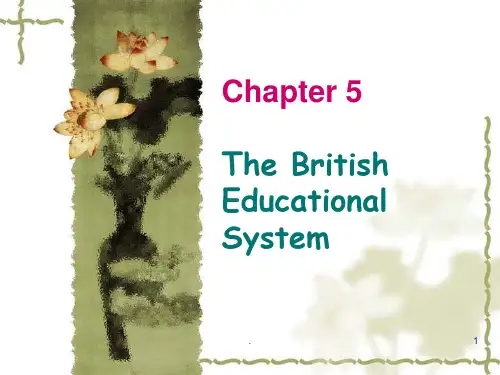
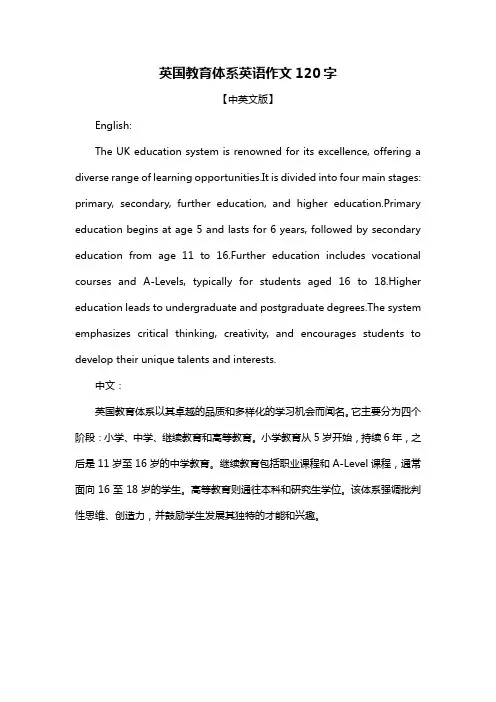
英国教育体系英语作文120字【中英文版】English:The UK education system is renowned for its excellence, offering a diverse range of learning opportunities.It is divided into four main stages: primary, secondary, further education, and higher education.Primary education begins at age 5 and lasts for 6 years, followed by secondary education from age 11 to 16.Further education includes vocational courses and A-Levels, typically for students aged 16 to 18.Higher education leads to undergraduate and postgraduate degrees.The system emphasizes critical thinking, creativity, and encourages students to develop their unique talents and interests.中文:英国教育体系以其卓越的品质和多样化的学习机会而闻名。
它主要分为四个阶段:小学、中学、继续教育和高等教育。
小学教育从5岁开始,持续6年,之后是11岁至16岁的中学教育。
继续教育包括职业课程和A-Level课程,通常面向16至18岁的学生。
高等教育则通往本科和研究生学位。
该体系强调批判性思维、创造力,并鼓励学生发展其独特的才能和兴趣。
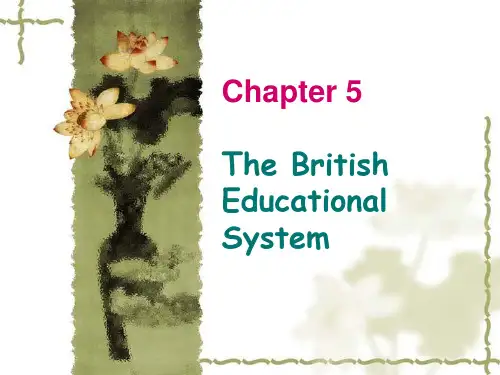
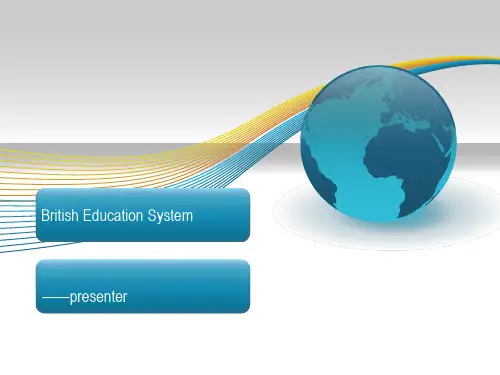
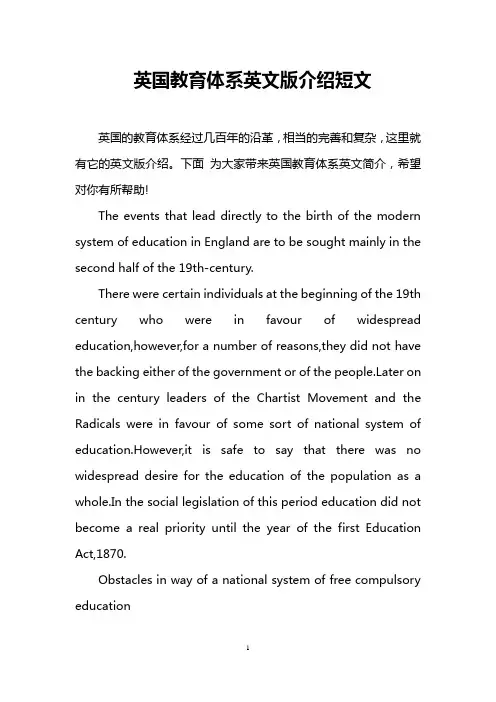
英国教育体系英文版介绍短文英国的教育体系经过几百年的沿革,相当的完善和复杂,这里就有它的英文版介绍。
下面为大家带来英国教育体系英文简介,希望对你有所帮助!The events that lead directly to the birth of the modern system of education in England are to be sought mainly in the second half of the 19th-century.There were certain individuals at the beginning of the 19th century who were in favour of widespread education,however,for a number of reasons,they did not have the backing either of the government or of the ter on in the century leaders of the Chartist Movement and the Radicals were in favour of some sort of national system of education.However,it is safe to say that there was no widespread desire for the education of the population as a whole.In the social legislation of this period education did not become a real priority until the year of the first Education Act,1870.Obstacles in way of a national system of free compulsory educationThe establishment of a national system of education came late in England mainly because of the social,economic and religious climate of the century.1.The higher classes of society had no interest in advocating the cultural development of the working classes.On the contrary,the effects of the revolutionary spirit in Europe reinforced conservative attitudes that were certainly not conducive to advocating the development of the critical faculties of the people as a whole.2.Neither did the vast majority of the working class have any real interest in education.Child labour was common practice in this period and working-class families were very reluctant to give up the earnings of their children for the benefit of education.The employment of children continued to increase even after 1850.3.Also the effect of Protestantism,with its emphasis on individualism,personal salvation,the private reading and interpretation of Scripture,ran contrary to any sort of collectivist thought.4.Religious conflict also delayed the establishment of a national system of education.One example of this can be seen in the reaction to the clauses regarding education in the 1843Factory Bill.There was violent opposition on the part of nonconformists and Catholics alike because,according to the Bill,headmasters had to be of the Church of England.Furthermore,the children were to be taught the catechism and be present at liturgical celebrations as well as service on Sundays.The Bill failed.5.The idea of secular education had never been popular during the cation had almost exclusively been under the control of the established church.Furthermore,we should not forget the conflict between secular and religious thought that characterised the century,especially the latter half.Given the cultural and religious climate of the century it became obvious that any nondenominational system of education would be well nigh impossible.It was only in the 20th century,with the rise of indifference towards religious teaching,that general nondenominational schooling became possible.Denominational education was further reinforced by the increase in the Catholic population due to the wave of Irish immigrants during and following the Great Famine in Ireland (1845-50).6.It was also thought that the voluntary school system was quite successful and that it was better not to encouragegovernment intervention.Furthermore,the dominant laissez-faire theory of the time meant that,as in most areas,any direct intervention on the part of the state in the field of education was to be discouraged.The state was only too happy to leave education to the private sector,voluntary or cation could not constitute an exception to the tenaciously upheld doctrine of laissez-faire.However,these voluntary institutions did not have the influence or power to construct a nationwide system.Economic development and the increase of wealth were seen to be priority issues.The question of education only attracted very limited attention.Tendencies and events favouring national educationNot everything was negative; there were quite distinct undercurrents of thought beginning to emerge that eventually led to the 1870 Education Act.During the century,and particularly during the second half,we have the beginnings of a national system of education that owes its birth to many factors.1.From the first decade of the 19th-century there emerged indications of new thinking in the field of education.Of particular interest is the Bill introduced into theHouse of commons by Samuel Whitbread in 1807.2.In 1807 Samuel Whitbread proposed to deal with the whole of the Poor Law with the introduction of a Bill in the House of Commons.Of particular interest is the first part of the Bill,which dealt specifically with education.Whitbread advocated making the parish responsible for education and proposed that each child should have two years of education between the ages of 7 and 14.He thought this would reduce crime and pauperism.3.It was considered too expensive to implement and it was also thought that the introduction of such a scheme would take the people away from manual work and make them dissatisfied with their social situation.Although unsuccessful the thought of generalised education for the masses was even then being expressed and was later to be reiterated constantly throughout the century eventually leading up to the 1870 Education Act.4.The idea of widespread education was also helped by the gradual increase in collectivist thought especially after 1865.This is quite evident in the works of Carlyle and Ruskin.It was only after this date that any idea of widespread state intervention in the field of education could find fertile ground.5.The various Factory Acts of 1833,1844,and 1867 were another contributory factor towards the general tendency towards national education.These acts focused not only on the condition of workers but they also had the effect of imposing certain restrictions on child labour,which in turn favoured the opportunity of an alternative:education for the child.6.In the second half of the 19th-century crime and pauperism increased,so did riots strikes and social unrest.The commercial and manufacturing supremacy of Britain was in decline and this was seen to be mostly due to the fact that other European countries had a more developed technical education system.Political stability and economic prosperity now seemed to be associated with the education of the cation now seemed financially viable.7.In 1869 two other societies were established:the Education League,which turned secular and the National Education Union,which was conservative and Anglican.It was mainly due to these two societies that the Education Act of 1870 was passed.The Education Act of 1870It was with the Education Act of 1870,also known as the "Forster Act",that we have the real birth of themodern system of education in England.This not only gave rise to a national system of state education but also assured the existence of a dual system - voluntary denominational schools and nondenominational state schools.The act required the establishment of elementary schools nationwide.These were not to replace or duplicate what already existed but supplement those already run by the churches,private individuals and guilds.The country was divided into school districts and in those areas where there was inadequate provision school boards were to be elected.These were responsible for raising sufficient funds to maintain the schools.The schools were often called " board schools".These elementary schools had to be non-denominational.The school boards could charge a weekly fee not exceeding 9 pence.For a limited period the school boards could pay the fees if the parents were unable to do so.The Voluntary Schools could also receive such payment of fees from the school boards.They had to guarantee attendance for all children in their respective districts between the ages of 5 and 13.The School Board could appoint officers to enforce attendance.Theseofficers or "Board Men",as they were commonly known,became one of those terribly menacing figures firmly implanted in the minds of young schoolboys.This figure was an effective deterrent in playing truant.All the more menacing because the child could only picture him in his imagination (if he faithfully attended school,that is!).He was also known as the School Attendance Officer.Religious instruction was an integral part of the school curriculum but was not compulsory.This was to be nondenominational.Since 1870 Voluntary Schools declined except Roman Catholic Schools because Boards Schools provided better buildings and higher pay for teachers.Elementary education became effectively free with the passing of the 1891 Education Act.英国教育体系介绍英国教育体系总体来说分为三个阶段:义务教育(Compulsory Education),延续教育(Further Education)和高等教育(Higher Education)。
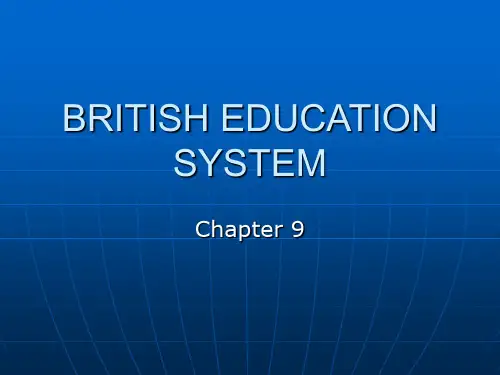
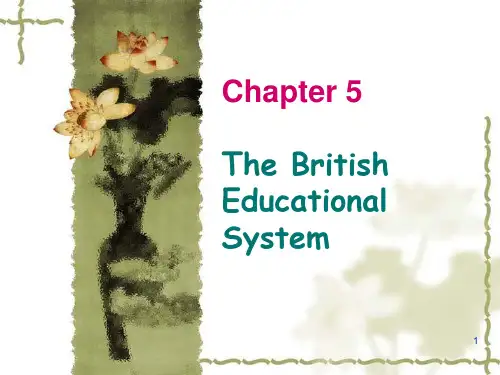
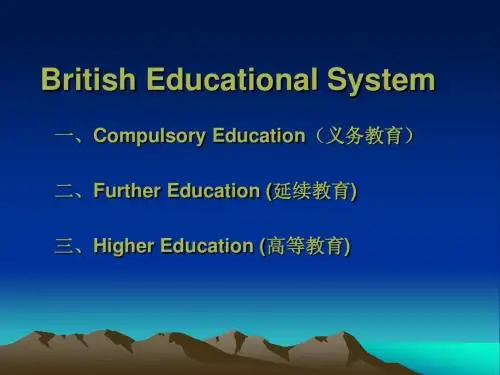
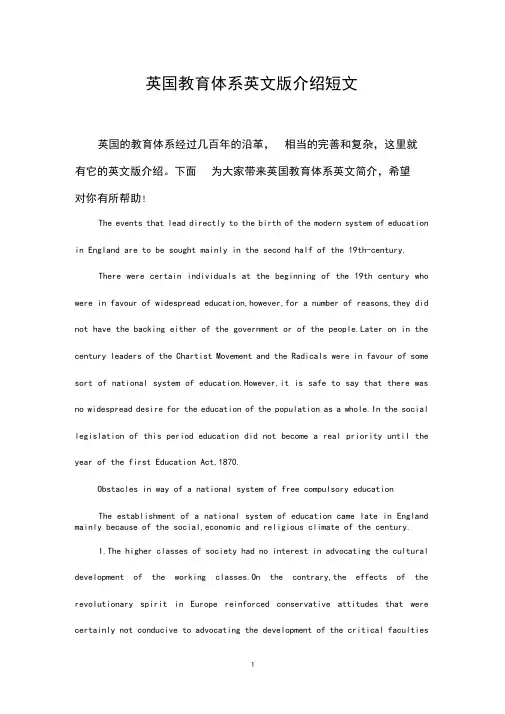
英国教育体系英文版介绍短文英国的教育体系经过几百年的沿革,相当的完善和复杂,这里就有它的英文版介绍。
下面为大家带来英国教育体系英文简介,希望对你有所帮助!The events that lead directly to the birth of the modern system of education in England are to be sought mainly in the second half of the 19th-century.There were certain individuals at the beginning of the 19th century who were in favour of widespread education,however,for a number of reasons,they did not have the backing either of the government or of the ter on in the century leaders of the Chartist Movement and the Radicals were in favour of some sort of national system of education.However,it is safe to say that there was no widespread desire for the education of the population as a whole.In the social legislation of this period education did not become a real priority until the year of the first Education Act,1870.Obstacles in way of a national system of free compulsory educationThe establishment of a national system of education came late in England mainly because of the social,economic and religious climate of the century.I.The higher classes of society had no interest in advocating the cultural development of the working classes.On the contrary,the effects of the revolutionary spirit in Europe reinforced conservative attitudes that were certainly not conducive to advocating the development of the critical facultiesof the people as a whole.2.Neither did the vast majority of the working class have any real interest in education.Child labour was commonpractice in this period and working-class families were very reluctant to give up the earnings of their children for the benefit of education.The employment of children continued to increase even after 1850.3.Also the effect of Protestantism,with its emphasis on individualism,personal salvation,the private reading and interpretation of Scripture,ran contrary to any sort of collectivist thought.4.Religious conflict also delayed the establishment of a national system of education.One example of this can be seen in the reaction to the clauses regarding education in the 1843Factory Bill.There was violent opposition on the part of nonconformists and Catholics alike because,according to the Bill,headmasters had to be of the Church of England.Furthermore,the children were to be taught the catechism and be present at liturgical celebrations as well as service on Sundays.The Bill failed.5.The idea of secular education had never been popular during the cation had almost exclusively been under the control of the established church.Furthermore,we should not forget the conflict between secular and religious thought that characterised the century,especially the latter half.Given the cultural and religious climate of the century it became obvious that any nondenominational system of education would be well nigh impossible.Itwas only in the 20th century,with the rise of indifference towards religious teaching,that general nondenominational schooling became possible.Denominational education was further reinforced by the increase in the Catholic population due to the wave of Irish immigrants during and following the Great Famine in Ireland (1845-50).6.It was also thought that the voluntary school system was quite successful and that it was better not to encouragegovernment intervention.Furthermore,the dominant laissez-faire theory of the time meant that,as in most areas,any direct intervention on the part of the state in the field of education was to be discouraged.The state was only too happy to leave education to the private sector,voluntary or cation could not constitute an exception to the tenaciously upheld doctrine of laissez-faire.However,these voluntary institutions did not have the influence or power to construct a nationwide system.Economic development and the increase of wealth were seen to be priority issues.The question of education only attracted very limited attention.Tendencies and events favouring national educationNot everything was negative; there were quite distinct undercurrents of thought beginning to emerge that eventually led to the 1870 EducationAct.During the century,and particularly during the second half,we have the beginnings of a national system of education that owes its birth to many factors.1.From the first decade of the 19th-century there emerged indications of new thinking in the field of education.Of particular interest is the Bill introduced into theHouse of commons by Samuel Whitbread in 1807.2.In 1807 Samuel Whitbread proposed to deal with the whole of the Poor Law with the introduction of a Bill in the House of Commons.Of particular interestis the first part of the Bill,which dealt specifically with education.Whitbread advocated making the parish responsible for education and proposed that each child should have two years of education between the ages of 7 and 14.He thought this would reduce crime and pauperism.1.It was considered too expensive to implement and it was also thought that the introduction of such a scheme would take the people away from manual work and make them dissatisfied with their social situation.Although unsuccessful the thought of generalised education for the masses was even then being expressed and was later to be reiterated constantly throughout the century eventually leading up to the 1870 Education Act.4.The idea of widespread education was also helped by the gradual increase in collectivist thought especially after 1865.This is quite evident in the works of Carlyle and Ruskin.It was only after this date that any idea of widespread state intervention in the field of education could find fertile ground.5.The various Factory Acts of 1833,1844,and 1867 were another contributory factor towards the general tendency towards national education.These acts focused not only on the condition of workers but theyalso had the effect of imposing certain restrictions on child labour,which in turn favoured the opportunity of an alternative:education for the child.6.In the second half of the 19th-century crime and pauperism increased,so did riots strikes and social unrest.The commercial and manufacturing supremacy of Britain was in decline and this was seen to be mostly due to the fact thatother European countries had a more developed technical education system.Political stability and economic prosperity now seemed to be associated with the education of the cation now seemed financially viable.7.In 1869 two other societies were established:the Education League,which turned secular and the National Education Union,which was conservative and Anglican.It was mainly due to these two societies that the Education Act of 1870 was passed.The Education Act of 1870It was with the Education Act of 1870,also known as the "Forster Act",that we have the real birth of the modern system of education in England.This not only gave rise to a national system of state education but also assured the existence of a dual system - voluntary denominational schools and nondenominational state schools.The act required the establishment of elementary schools nationwide.These were not to replace or duplicate what already existed but supplement those already run by the churches,private individuals and guilds.The country was divided into school districts and in those areas where there was inadequate provision school boards were to be elected.These were responsible for raising sufficient funds to maintain the schools.The schools were often called " board schools".These elementary schools had to be non-denominational.The school boards could charge a weekly fee not exceeding 9 pence.For a limited period the schoolboards could pay the fees if the parents were unable to do so.The Voluntary Schools could also receive such payment of fees from the school boards.They had to guarantee attendance for all children in their respective districts between the ages of 5 and 13.The School Board could appoint officers to enforce attendance.These officers or "Board Men",as they were commonly known,became one of those terribly menacing figures firmly implanted in the minds of young schoolboys.This figure was an effective deterrent in playing truant.All the more menacing because the child could only picture him in his imagination (if he faithfully attended school,that is!).He was also known as the School Attendance Officer.Religious instruction was an integral part of the school curriculum but was not compulsory.This was to be nondenominational.Since 1870 Voluntary Schools declined except Roman Catholic Schools because Boards Schools provided better buildings and higher pay for teachers.Elementary education became effectively free with the passing of the 1891 Education Act.英国教育体系介绍英国教育体系总体来说分为三个阶段:义务教育(Compulsory Education),延续教育(Further Education)和高等教育(Higher Education)。
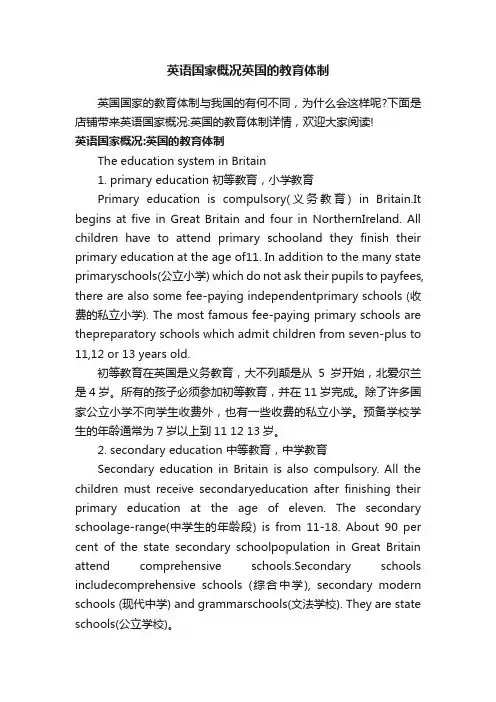
英语国家概况英国的教育体制英国国家的教育体制与我国的有何不同,为什么会这样呢?下面是店铺带来英语国家概况:英国的教育体制详情,欢迎大家阅读!英语国家概况:英国的教育体制The education system in Britain1. primary education 初等教育,小学教育Primary education is compulsory(义务教育) in Britain.It begins at five in Great Britain and four in NorthernIreland. All children have to attend primary schooland they finish their primary education at the age of11. In addition to the many state primaryschools(公立小学) which do not ask their pupils to payfees, there are also some fee-paying independentprimary schools (收费的私立小学). The most famous fee-paying primary schools are thepreparatory schools which admit children from seven-plus to 11,12 or 13 years old.初等教育在英国是义务教育,大不列颠是从5岁开始,北爱尔兰是4岁。
所有的孩子必须参加初等教育,并在11岁完成。
除了许多国家公立小学不向学生收费外,也有一些收费的私立小学。
预备学校学生的年龄通常为7岁以上到11 12 13岁。
2. secondary education 中等教育,中学教育Secondary education in Britain is also compulsory. All the children must receive secondaryeducation after finishing their primary education at the age of eleven. The secondary schoolage-range(中学生的年龄段) is from 11-18. About 90 per cent of the state secondary schoolpopulation in Great Britain attend comprehensive schools.Secondary schools includecomprehensive schools (综合中学), secondary modern schools (现代中学) and grammarschools(文法学校). They are state schools(公立学校)。
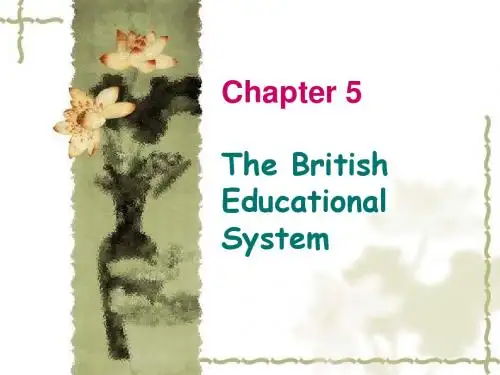
英国英文简介带翻译Title: A Brief Introduction to the Education System in the United Kingdom。
英国教育系统简介。
The education system in the United Kingdom is highly respected around the world and is known for its quality and diversity. From primary school to university, the UK offers a wide range of educational opportunities for students of all ages and backgrounds.英国的教育系统在全球范围内备受尊重,以其质量和多样性而闻名。
从小学到大学,英国为不同年龄和背景的学生提供广泛的教育机会。
Primary and Secondary Education。
Primary education in the UK typically starts at the age of four or five and lasts for six years. During this time,students learn basic subjects such as math, English, science, and social studies. Secondary education follows primary education and lasts for five years, from the age of 11 to 16. Students study a wider range of subjects,including foreign languages, history, geography, and art.英国的小学教育通常从四五岁开始,为期六年。
英国的教育体系英国的教育体系英国是世界排名前位的教育强国,因为英国有着世界上最著名最古老的学府,所以每年吸引了众多留学生前往英国留学,下面店铺就和大家来说说英国的教育体系吧!一、英国教育体系英国是一个有着悠久教育传统的国家。
它的教育体系经过几百年的沿革,相当的完善和复杂,且具有非常大的灵活性。
总体来说,英国教育分为三个阶段:义务教育(Compulsory Education),延续教育(Further Education)和高等教育(Higher Education)。
英国教育体系一般分为五个阶段:第一阶段3岁到5岁的幼儿园教育;第二阶段5-11岁的小学教育;第三阶段11岁-16岁的中学教育;5岁-16岁为法律规定的强制教育阶段。
适龄儿童必须入学,由国家负责必须的学费、书籍和必要的供应。
第四阶段16岁-18岁是中学高级班(或大学预备班),为中学至大学的过渡期,也称继续教育阶段,主要是学术方向和职业方向学习。
完成预科的学生主要参加普通教育高级考试(general certificate of education,advanced level,简称GCE-A level),而职业技校的学生除了要参加GCE-A level考试外,还要参加普通国家职业资格考试(General National Vocational Qualification,简称GNVQ);第五阶段大学教育。
一般从18岁开始,读本科需要3年-4年(医科为5年),可取得学士学位。
硕士通常为1年-2年,博士为3年-5年。
二、英国教学质量英国的教育体系得到了世界各地的认可。
为了能继续保持高标准,英国教育实行的是一套独特的质量保证体系,每所学校、延续教育和高等教育机构都得接受教育质量监管部门严格的监督检查。
许多独立组织也会定期对英国的院校及课程进行督察和认证。
按照统一的标准对每门课程进行评估,让学生可以更好地了解各所学校在同一专业上的教学质量如何。